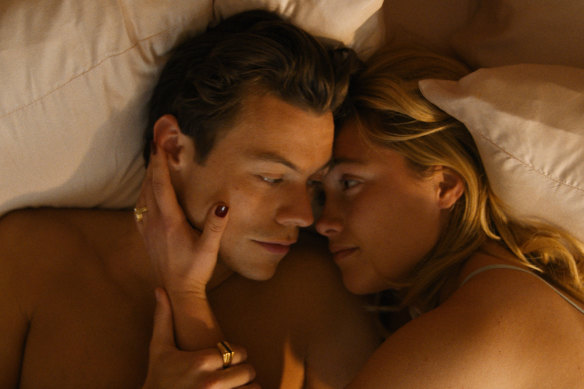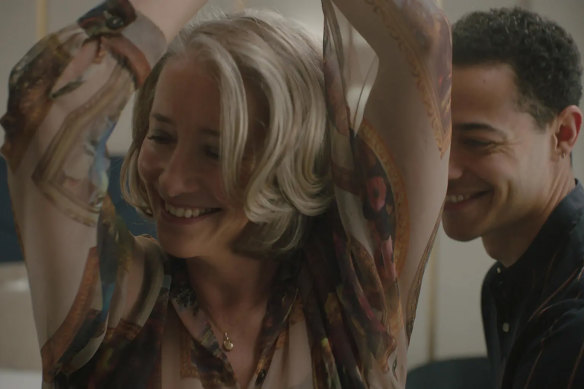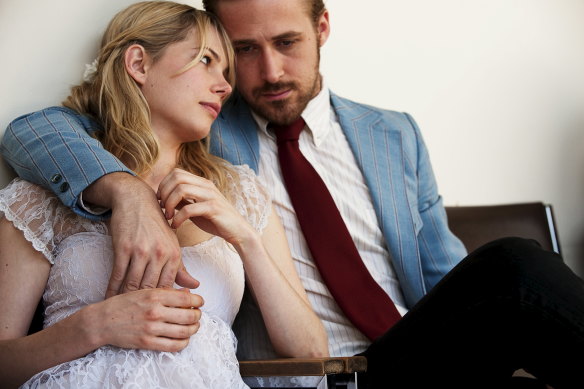Perhaps it’s not surprising that it has taken two female writer/directors to finally change the way women and sex are depicted in Hollywood movies. What is surprising is that it’s only happened this year.
Olivia Wilde’s Don’t Worry Darling and Good Luck to You, Leo Grande, directed by Sophie Hyde, both put women’s sexual pleasure front and centre, a hard pivot from decades of on-screen depictions of sex that rarely, if ever, focus on women’s desires.
Harry Styles, left, and Florence Pugh in “Don’t Worry Darling.” Credit:Warner Bros. Entertainment via AP
Wilde has been vocal about the issue, asking: why isn’t there good sex in films any more? She is on the record as saying that one particular scene in her latest offering is intended to make audiences “realise how rarely they see female hunger, and specifically this type of female pleasure”.
That most Hollywood movies have been written and directed by men until relatively recently is a major factor. Even so, it is remarkable that in 2022, the most famous Hollywood scene of a woman having an orgasm on-screen is still of a woman faking it: Meg Ryan in When Harry Met Sally.
Catharine Lumby, media professor at the University of Sydney, says it’s a conservative narrative that still privileges straight, white, male men. “The elephant in the room is pleasure, particularly female pleasure. In popular culture, there’s a lot of representation of male pleasure and male sexuality is often represented as very libidinal, it’s very out there, like ‘of course men want sex’.”
Directed by Sophie Hyde and written by Katy Brand, Good Luck to You Leo Grande stars Emma Thompson and Daryl McCormack.
The same cannot be said for the portrayal of women. Lumby argues it goes right back to the fact that women are still in an unspoken way taught shame about their bodies, whether it’s about periods or orgasms. “We don’t live in a culture that licenses discussions about female sexuality. I think we’ve become more conservative, if you look back to the 70s.”
Some of the most accurate representations of women’s sexual pleasure, she says, are in music, with releases such as Cardi B’sWAP breaking new ground.
Ratings are a significant factor in determining what can and can’t be shown but the governing bodies can and do make problematic decisions. Actor Ryan Gosling weighed into the discussion when the Motion Picture Association (MPAA) in America, gave Blue Valentine an NC-17 rating – because it contains a scene where Gosling’s character performs oral sex on Michelle Williams.
In a statement issued at the time in 2010, Gosling said: “You have to question a cinematic culture which preaches artistic expression, and yet would support a decision that is clearly a product of a patriarchy-dominant society, which tries to control how women are depicted on screen.
“The MPAA is okay supporting scenes that portray women in scenarios of sexual torture and violence for entertainment purposes, but they are trying to force us to look away from a scene that shows a woman in a sexual scenario, which is both complicit and complex. It’s misogynistic in nature to try and control a woman’s sexual presentation of self. I consider this an issue that is bigger than this film.”
Ryan Gosling and Michelle Williams in Blue Valentine.
In the late 1980s and early ’90s, a spate of Hollywood films did show women having sex and enjoying themselves, but they were all femme fatale plots. The female protagonists are sexual, empowered and deranged – after sex, they become obsessed and want to kill their partners; think Fatal Attraction and Basic Instinct.
Wilde referenced Fatal Attraction as one of the inspirations for her latest film, alongside Indecent Proposal, saying those movies are “really sexy, in a grown-up way”.
However, they still only featured female sexuality as part of a messier, darker narrative, according to Lumby.
“The bunny boiler in Fatal Attraction, the ice pick in Basic Instinct: often when women have been portrayed in Hollywood movies as having sexual agency, there has to be something lurking inside them that’s coming [to get] men.”
Sydney-based visual artist Julie Rrap often uses her naked body in her work. She says it’s interesting to think that all those big studios are run by male bosses, “that’s always the controlling temperature really”.
“Not even just in terms of women and sex but you often hear directors who we would regard as really significant filmmakers talking about the restrictions that are placed on them. I don’t think there are any surprises there, that in Hollywood they are just interested in popular consumption.”
To her mind, it makes sense that Hollywood would err on the side of caution rather than anything radical. The absence of women having sex from mainstream offerings leads her to think about the need for a broader conversation about the place of pleasure, which is not necessarily part of sex education.
ACMI curator Julia Murphy says throughout the history of the Hollywood studio system, the representation of women on screen has generally been defined by stereotypes, limited sexual expression, and the male gaze. “When women are involved in the financial and creative process of screen production, we see more realistic and less conservative portrayals of intimacy on screen,” she says.
The Hays Code, which decreed what could and could not be featured in films coming out of the famous Los Angeles studios for many years, might still have a hangover effect. Its prescriptive, old-school notions were a backlash against a time of women’s liberation and societal freedom.
According to ACMI curator Chelsey O’Brien, the 1920s were a super-racy time in Hollywood. Films were beginning to mature and deal with adult content. “They were sort of racy and projected images of women in power and making their own choices. There were off-screen stories of drugs and alcohol and partying and overindulgence and then the industry was rocked by really huge scandals … all of these things brought really widespread condemnation from religious, civic and political organisations. Many felt that the movie industry was really morally questionable so there was all this political pressure.”
The Hays Code was a self-imposed industry set of guidelines for all the motion pictures that were released between 1934 and 1968, says O’Brien. “The code prohibited profanity, suggestive nudity, graphic or realistic violence, sexual persuasions and rape. It had rules around the use of crime, costume, dance, religion, national sentiment and morality,” she says.
“And according to the code – even within the limits of pure love or realistic love – certain facts have been regarded as outside the limits of safe presentation. So basically, this means we have a whole lot of married couples sleeping in separate beds for at least 20 years.”
Arthouse cinema and indeed European cinema is much more in keeping with the times; the exquisite French drama Betty Blue from 1996 is one memorable example, with an unforgettable opening scene. In streaming land, it’s a very different picture as well: Outlander and Bridgerton are two recent shows that feature quite a bit of sex.
In 1973, British feminist film writer Laura Mulvey wrote a seminal essay called “Visual Pleasure and Narrative Cinema”, which explored how mainstream films appealed to a male gaze – a term she coined – because the industry was dominated by men who, inevitably, constructed representations of women from a masculine point of view. All these years on, that continues to hold true, in Hollywood at least, and it seems likely to do so until more stories are written and directed by women.
Find out the next TV, streaming series and movies to add to your must-sees. Get The Watchlist delivered every Thursday.
Most Viewed in Culture
From our partners
Source: Read Full Article



